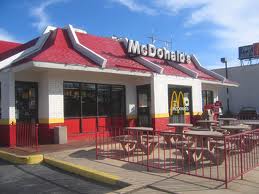Most standalone McDonald’s restaurants offer both counter and drive-through service, with indoor and sometimes outdoor seating. The Drive-Thru, Auto-Mac, or McDrive as it is known in many countries, often has separate stations for placing, paying for, and picking up orders, though the former two steps are frequently combined. In some countries “McDrive” locations near highways offer no counter service or seating. In contrast, locations in high-density city neighborhoods often omit drive-through service.
How much does it cost to open a McDonald’s Franchise?
Term of Agreement: 20 years
How do you create a restaurant empire and become an overnight success at the age of 52? As Ray Kroc said, “I was an overnight success all right, but 30 years is a long, long night.”
Origins
In 1917, 15-year-old Ray Kroc lied about his age to join the Red Cross as an ambulance driver, but the war ended before his training finished. He then worked as a piano player, a paper cup salesman and a multi-mixer salesman.
In 1954 he was surprised by a huge order for 8 multi-mixers from a restaurant in San Bernardino, California. There he found a small but successful restaurant run by brothers Dick and Mac McDonald, and was stunned by the effectiveness of their operation. They produced a limited menu, concentrating on just a few items—burgers, fries and beverages—which allowed them to focus on quality at every step.
Kroc pitched his vision of creating McDonald’s restaurants all over the U.S. to the brothers. In 1955 he founded the McDonald’s Corporation, and 5 years later bought the exclusive rights to the McDonald’s name. By 1958, McDonald’s had sold its 100 millionth hamburger.
A Unique Philosophy
Ray Kroc wanted to build a restaurant system that would be famous for food of consistently high quality and uniform methods of preparation. He wanted to serve burgers, buns, fries and beverages that tasted just the same in Alaska as they did in Alabama.
Rewarding Innovation
Ray Kroc believed in the entrepreneurial spirit, and rewarded his franchisees for individual creativity. Many of McDonald’s most famous menu items—like the Big Mac, Filet-O-Fish and the Egg McMuffin— were created by franchisees. At the same time, the McDonald’s operating system insisted franchisees follow the core McDonald’s principles of quality, service, cleanliness and value.
The Roots of Quality
McDonald’s passion for quality meant that every single ingredient was tested, tasted and perfected to fit the operating system. As restaurants boomed, the massive volume of orders caught the attention of suppliers, who began taking McDonald’s standards as seriously as McDonald’s did. As other quick service restaurants began to follow, McDonald’s high standards rippled through the meat, produce and dairy industries.
Again, Ray Kroc was looking for a partnership—this time with McDonald’s suppliers—and he managed to create the most integrated, efficient and innovative supply system in the food service industry. These supplier relationships have flourished over the decades: in fact, many McDonald’s suppliers operating today first started business with a handshake from Ray Kroc.
Hamburger University
In 1961, Ray launched a training program, later called Hamburger University, at a new restaurant in Elk Grove Village, Illinois. There, franchisees and operators were trained in the scientific methods of running a successful McDonald’s. Hamburger U also had a research and development laboratory to develop new cooking, freezing, storing and serving methods. Today, more than 80,000 people have graduated from the program.
The End of a Legend
Right up until he died on January 14, 1984, Ray Kroc never stopped working for McDonald’s. Even when he was confined to a wheelchair, he still went to work in the office in San Diego nearly every day. He would keep a hawk’s eye over the McDonald’s restaurant near his office, phoning the manager to remind him to pick up the trash, clean his lot, and turn on the lights at night.




















